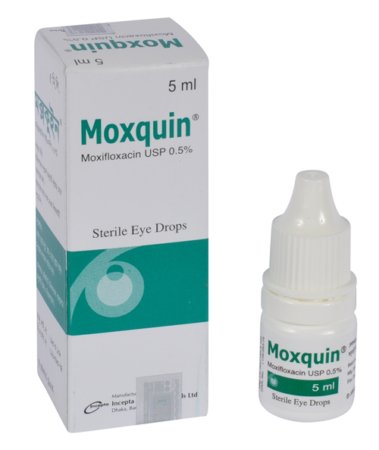
Type:5ml drop
Generic Name:Moxifloxacin 0.5% Eye prep
Manufacturer:Incepta Pharmaceuticals Ltd.
Price:৳160.00
Bacterial Conjunctivitis. This drug is indicated to increase tear production in patients whose tear production is suppressed due to ocular inflammation associated with dry eye syndrome (keratoconjunctivitis sicca).
Ophthalmic Bacterial conjunctivitis Adult: As 0.5% soln: Instill 1 drop into the affected eye(s) bid-tid for 7 days. It can be used concomitantly with artificial tears, allowing a 15 minute interval between products.
Ophthalmic Bacterial conjunctivitis Child: >1 yr: Instill 1 drop into the affected eye(s) tid for 7 days.
Patients with a history of hypersensitivity to Moxifloxacin, to other Quinolones or to any of the components in this medication
Moxifloxacin inhibits the topoisomerase II (DNA gyrase) and topoisomerase IV required for bacterial DNA replication, transcription, repair and recombination.
As with other anti-infectives, prolonged use may result in overgrowth of non-susceptible organisms, including fungi. If superinfection occurs, discontinue use and institute alternative therapy. To prevent contamination do not touch the tip of the dropper to eye, eyelid or any surface of of the affected eye. Keep the bottle tightly closed after use. Lactation: Unknown whether drug is excreted in breast milk; use with caution
1-10% Conjunctivitis,Dry eye,Fever,Increased cough,Infection,Ocular discomfort,Ocular hyperemia,Ocular pain,Ocular pruritus,Otitis media.Pharyngitis,Rash,Rhinitis,Subconjunctival hemorrhage.Tearing
Additive effect on QT interval prolongation w/ other drugs that prolong QT interval (e.g. erythromycin, TCAs, antipsychotic agents). Decreased absorption and bioavailability w/ Al- or Mg-containing antacids, or Fe or Zn preparations. Concomitant use of corticosteroids increases the risk of severe tendon disorders esp in elderly (>60 yr). Decreased absorption w/ sucralfate or didanosine. Potentially Fatal: Concurrent use of class Ia (e.g. quinidine, procainamide) or III (e.g. amiodarone, sotalol) antiarrhythmic drugs or w/ other drugs that prolong QT interval (e.g. erythromycin, TCAs, antipsychotic agents) may cause additive effect on QT interval prolongation.